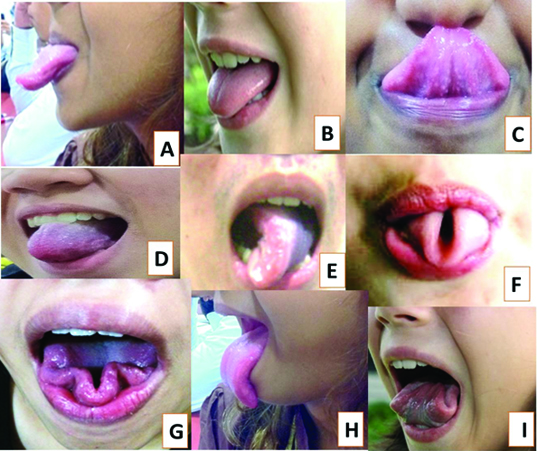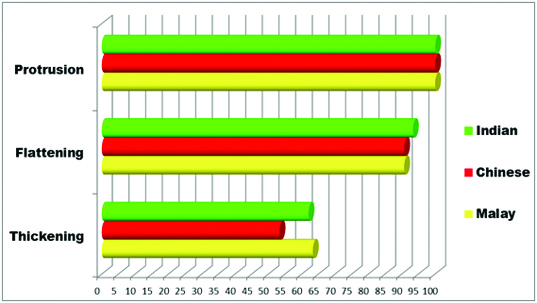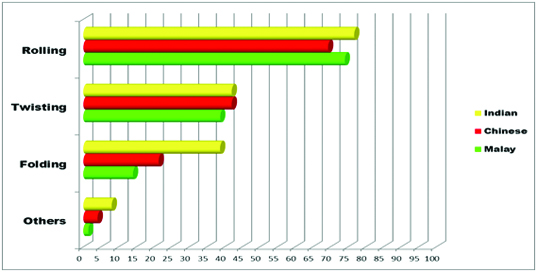The tongue is a highly muscular organ of deglutition, taste and speech. It has a root, an apex, curved dorsum and inferior surface. The dorsum of the tongue is divided into an anterior two third and a posterior one third part by sulcus terminalis. The anterior part of dorsal mucosa is covered with numerous small papillae, some of which bear taste buds. Its inferior surface is smooth and attached to the floor of oral cavity by the frenulum linguae [1].
The tongue is divided by a median fibrous septum into two halves. There are extrinsic and intrinsic muscles in each half, the former extending outside the tongue and moving it bodily, the latter wholly within it and altering its shape. The muscles of the tongue and their actions are as follows: The Intrinsic Muscles: Superior Longitudinal – shortens tongue & makes dorsum of tongue concave, Inferior Longitudinal – shortens tongue & makes dorsum of tongue convex, Transverse – narrows & elongates tongue, Vertical – broadens & flattens tongue. The Extrinsic Muscles: - Genioglossus - retract tip of tongue, depress tongue & protrude tongue, Hyoglossus – depress tongue & retract protruded tongue, Styloglossus – pulls the tongue upward and backward during swallowing, Palatoglossus – pulls up root of tongue [1]. Other than these normal movements a few people are also able to roll, fold and twist the tongue which is considered as special movements. The ability to roll the tongue is considered to be due to a pair of alleles. A study done by Edward et al., revealed that this ability to fold back the tip of the tongue could only be expressed by those who had the ability to roll up the lateral edges. These researchers also postulated that a pair of alleles controlled the tongue rolling and another pair of alleles was responsible for tongue folding. The folding allele, however, was recessive to its non-folding allele [2]. Twisting of the tongue is opined to be brought about chiefly by the unilateral action of the styloglossus muscle [3]. However, the ability of demonstrating tongue movements varies from person to person.
Tongue is mainly used for taste, chewing and in speech. In the present study, we focused on the secondary function of the tongue as to how the tongue is used in phonetic pronunciation and dialectology and how these factors affect various tongue movements. Most of the studies carried out on tongue movements focus mainly on the role of tongue in speech as this plays a dominant role in human interactions. Mac Neilage postulates that movements of the tongue and jaw in speech (which he terms ‘cyclicities’) have been evolved from their movements in infantile babbling. But, till date there are no studies done in this regard to test it experimentally [4]. A number of studies have reported that tongue movements are produced by a small number of independent components which alters the shape of the tongue during speech. The tongue patterns exhibited during speech has been said to reflect both: the strategies of the speaker and constraints that are imposed by virtue of the physical properties of the tongue [5]. In this piece of research, we wanted to test our hypothesis that “there is a clear correlation between the languages spoken by an individual and his ability to perform various tongue movements”.
Thus our first objective was to compare all possible movements of tongue among medical students of Malaysia belonging to three ethnic races. The second objective of the study was to find out if there is any link between languages spoken and ability to perform various tongue movements.
Materials and Methods
Sample size
This was a cross-sectional study in which a total of 450 undergraduate medical students aged 17-19 years participated. The students who belonged to three different Malaysian ethnic races i.e. Malays, Chinese and Indians (Malaysian Indians) were chosen randomly. Ethical clearance was obtained prior to the study and respondents gave their informed consent before taking part in this study. Among Malay: 45 were males and 99 females, 66 were males and 79 were females among Chinese and among Indians: 57 were males and 70 were female students. The period of study was six months. Students who volunteered to take part in the study and who could speak and understand English were selected. Students with any congenital anomaly of the tongue, wounds or ulcers on the tongue were excluded from the study.
Data collection
The relevant data was collected from the students through a semi-structured interview. In this method, each participant was interviewed personally and the interview included: filling up an interview form, answering few questions and demonstration of tongue movements. Each student was given a printed interview form which was in English in which he or she was told to fill up certain details such as name, age, gender, ethnicity and languages spoken by him/her including his/her mother tongue. Following this, each student was asked to demonstrate the following tongue movements if possible:- Protrusion, retraction, flattening, thickening, rolling, twisting, folding or any other special movements such as touching nose with tongue, touching chin with tongue, ‘W’ shaped tongue etc. A volunteer was selected who could perform all the above tongue movements. He at first demonstrated each tongue movement to the participants and then the participants were asked to perform the same movements. The instructions for performing the tongue movements were given in English. The various movements which could be performed by the participants were noted down in the interview form.
Photographs of tongue movements of selected students were taken alongside relevant video recordings wherever needed. The photographs were taken with prior consent of the participants.
Data analysis
All the data which was obtained was first segregated and analysed according to gender, and then according to race. Number of students who were able to do different movements of the tongue was tabulated. The respective percentages were calculated and then comparison was made between males and females and then segregated according to their race. The same data was then analysed according to types and dialects of languages spoken. The various languages spoken by the participants were: English, Bahasa Melayu (Malay), Mandarin, Cantonese, Hokkien, Hakka, Foo Chow, Teow Chew, Tamil, Hindi, Punjabi, Malayalam, Telugu and miscellaneous (Siamese, Burmese, French, Creole, Sinhalese, Thai, German, Arabic, Korean, Java). This information was obtained from the interview form filled by the participants.
The ability of the students to perform various tongue movements who spoke these respective languages were tabulated and the percentage was calculated. We chose Malaysian students as they belonged to three different ethnic races and hence we could compare the various tongue movements performed by them and could relate it to the range of languages spoken by them. All the information obtained was then analysed and correlated using SPSS v 16 statistical software. Correlation coefficient was calculated using the values of two variables (languages spoken and intricate movements of tongue) to determine whether they are associated to establish a positive relationship.
Results
We found that most of the Malaysian students were able to perform the basic actions of tongue like protrusion, flattening, thickening and rolling movements. A few were also able to perform twisting and folding of the tongue. Other special movements such as touching the tip of the nose with the tongue, touching the chin with the tongue, and ability to mould the tongue in a ‘clover leaf’ shape etc. was also possible for very few participants [Table/Fig-1]. Among the males and females we found that all could perform protrusion (100%). A 92% of males and 90% of females could do flattening of the tongue. The next movement possible was rolling movement followed by thickening of tongue. The different movements that were possible and their grouping according to the gender are shown in [Table/Fig-2]. Malaysian students belong to three different races i.e. Malay, Chinese and Indian. When we segregated the results and grouped it according to their race we found that all of them were able to perform protrusion. Flattening was possible among 34% Indians, followed by Malay and Chinese (33%). A 34.9% of Indians were able to roll their tongue followed by Malay (33.6%) and Chinese (31.5%). We also found that the ability to twist and fold the tongue was higher in Indians (34.3%, 52.3%) when compared to Malays and Chinese [Table/Fig-3]. This showed that among the Malaysians the ability to perform normal tongue movements like protrusion, flattening, thickening and special movements like folding, twisting, rolling and others was higher among Indians [Table/Fig-4,5] when compared to Malay and Chinese.
Photographs showing various tongue movements performed by students: a) Protrusion; b) Flattening; c) Touching nose with tongue; d) Thickening; e) Twisting; f) Rolling; g) Clover leaf shape; h) Touching chin with tongue; i) Folding.

Table showing the various movements possible in Malaysians in percentage.
| Male | Female |
|---|
| Protrusion | 100 | 100 |
| Flattening | 92.4 | 90.7 |
| Thickening | 68.9 | 50.2 |
| Rolling | 75.1 | 71.6 |
| Twisting | 38.2 | 43.6 |
| Folding | 27.1 | 22.2 |
| Others | 4.4 | 4.4 |
Table showing the tongue movements performed by the Malaysians and their segregation according to gender and race in percentage.
| Protrusion | Flattening | Thickening | Rolling | Twisting | Folding | Others |
|---|
| Malay male | 100.0 | 96.0 | 88.0 | 78.0 | 32.0 | 20.0 | 0.0 |
| Malay female | 100.0 | 86.0 | 39.0 | 71.0 | 46.0 | 9.0 | 3.0 |
| Chinese male | 100.0 | 91.5 | 60.6 | 77.0 | 43.7 | 18.3 | 1.4 |
| Chinese female | 100.0 | 91.1 | 46.8 | 60.8 | 40.5 | 24.1 | 6.3 |
| Indian male | 100.0 | 90.4 | 58.9 | 71.2 | 38.4 | 42.5 | 12.3 |
| Indian female | 100.0 | 96.1 | 64.8 | 82.9 | 44.7 | 34.2 | 3.9 |
Ability of Malaysians to Demonstrate Normal Tongue Movements in Percentage.

Ability of Malaysians to Demonstrate Special Tongue Movements in Percentage.

Further when we correlated the languages spoken by the three races of Malaysians and tongue movements we found that coefficient correlation (r score) was 0.97 which indicates a strong positive linear relationship between the 2 variables: languages spoken and tongue movements. Thus, languages spoken and intricate movements of tongue are positively correlated according to our study which is a very important finding.
Discussion
This study was done among the Malaysian students with the general assumption that the Malays speak Malay, the Chinese speak Mandarin, Cantonese or Hokkien and the Indians speak Tamil, Malayalam, Telugu or Hindi as their mother tongue. All subjects were able to speak English as a main language besides one of the above languages.
Based on our data analysis, we found that normal tongue movements such as protrusion, retraction, flattening and thickening don’t show a distinguishable variation among the Malaysians which included the Malay, Chinese and Indians. In the context of abnormal tongue movements which includes the following: Rolling, Folding, Twisting and other special movements such as touching the tip of the nose with the tongue, touching the chin with the tongue, and ability to mould the tongue in a ‘clover leaf’ shape, there was most obvious difference between all the three races and among them the Indians were the most capable to do these movements with a wide margin of difference. Movements such as rolling the tongue and twisting also exhibited the highest percentage amongst the Indians though the margin was not as wide as the other movements.
Given the fact that Malays speak the least number of languages as compared to the more diverse ability of the Chinese (able to speak more than one dialect) and Indians who are able to speak more than one language besides being able to speak Malay as a second language. This might be the reason for high percentage and diverse range of possible tongue movements of Indians and Chinese when compared to the Malay who have a lesser range of tongue movements.
Next, analysing the complexity of a certain language, the muscles involved in speaking the language, and specific intonations involved in articulating words; this has shown to alter the ability of one to demonstrate varying tongue movements. Based on the observation that the movements related to consonants and vowels tend to be independent of each other, Ohman argued that there may be atleast three independent tongue articulators, namely body (responsible for the front/back and up-down motions observed in vowels), apex (related to tongue tip movement) and dorsum (related to arching-flattening); the last two mostly involved in the generation of consonants [6]. Similarly, Perkell has suggested that separate sets of muscles control the position and shape of the tongue and that each articulator may be associated with a “small” number of muscles, two or three at most [7]. Based on some differences in their physiology, it was also suggested that extrinsic muscles are mainly responsible for positioning the tongue in the oral cavity (and, therefore, for vowel gestures) whereas the intrinsic muscles are responsible for controlling tongue shape (and, therefore, for consonants). The Bahasa Melayu language is a simple language that does not involve complex tongue movements. Pronunciation of words in this language is simple and it is monotonous. The traditional Chinese language involving dialects such as Mandarin, Cantonese, Hokkien, Teo Chew has a basic four tone pronunciation and involves mostly the laryngeal muscles instead of tongue muscles. Tamil and Hindi mainly spoken by Indians on the other hand involve detailed tongue rolling and folding in pronouncing certain words. Both languages have syllables that are enunciated with the help of tongue muscles. This may be the reason as to why generally Indians are more versatile with tongue movements as compared to the other two races amongst Malaysians. It is most probably with the persistent speaking of these languages over the years that has become an external factor which has enhanced the ability of one to demonstrate certain tongue movements beyond which is what coded genetically. Genetic variations seen in humans are usually a result of many factors related to the genes like selection, migration, gene - flow and genetic drift [8,9]. Researchers have opined that dominant gene is responsible for special movements like folding and rolling of the tongue while the recessive gene is linked with inability to perform these special movements [10]. Some other researchers who contradict this view believe that these traits are not genetically controlled but are learned traits [11]. Even though the effect of genetic factors on tongue movements is still been argued, these traits are of immense importance from physical anthropological point of view especially in studies related to population variation and human diversity [12].
In our comparison of tongue movements between males and females, we observed that males were able to perform normal and abnormal tongue movements more easily when compared to females except for twisting in which females predominated. These findings were different from previous studies as reported by Hernandez [13]. According to his study ability to roll the tongue in males was 63.1%, while in females this accounted for 66.84%. A similar study done among the Indians showed that there was no significant difference to perform tongue movements between males and females but they found lower incidence of tongue rollers and folders [14]. Odokuma et al., from the results obtained in their study opine that tongue folding and rolling traits are possible because of autosomal genes. He believes that selective expression arising from natural selection may be a reason for the observed variations in performing tongue movements [15]. Although this is yet to be proved; it shows the fact that genes a play an important role in the ability of a person to perform various tongue movements and their ability to speak diverse languages is not dependent on their gender. There are few studies which report the relationship between voice production and tongue movements, pronunciation training studies etc [16–18]. But there are very limited studies on correlation between tongue movements and languages spoken and hence we consider this as an important step forward towards studies related to this area. This information will be helpful for genetic studies in which gene mapping can be done to prove that tongue movements are influenced by genetic makeup of a person as till date there are no studies in this regard.
Conclusion
It can be concluded that many Malaysians are capable of performing various normal and special tongue movements. With the general assumption that Malays speak Bahasa Melayu, Chinese speak Mandarin and Hokkien popularly as their mother tongue and the Indians who speak Tamil and Malayalam, all Malaysians speak English as a main language and this does not serve as a variable. The results and percentage obtained were similar among the three races for all the listed tongue movements except for the ability to fold the tongue and other special movements whereby which the Indians obtained higher results followed by the Chinese and least – the Malays.
Results of our study show a strong positive correlation between languages spoken and intricate movements of tongue which suggests that there may be a possibility that languages spoken by a person serves as a variable that increases their ability to roll, fold, twist, thicken and perform special tongue movements besides influenced by the genetic makeup of a person.